Bulletin – August 2006 Australian Banks' Global Bond Funding[1]
- Download 69KB
Introduction
Over the past decade, Australian banks have sourced a sizeable share of their funding in offshore markets. This article examines various aspects of these funding activities, including whether Australian banks can raise funds at a lower cost in offshore markets relative to onshore, and whether Australian banks raising funds in offshore markets pay a premium relative to similar offshore institutions. Banks' average issuance costs domestically and offshore were found to be very similar over the period since 2001. This suggests that the banks have effectively arbitraged the differences in funding costs in domestic and offshore markets, raising funds where it has been most cost effective to do so. A comparison of Australian banks with similar institutions in the US shows that there is no evidence of any premium paid by Australian banks in raising funds in offshore markets.
Debt Issuance
Debt issuance by the Australian private sector, both domestically and offshore, has increased rapidly in recent years. The total amount of private sector bonds outstanding has risen from around $170 billion in 2000 to $560 billion by mid 2006. Offshore issues have accounted for around two-thirds of this increase (Graph 1). This increase in offshore issuance has been largely by financial institutions, predominantly banks, which issued nearly 80 per cent of their bonds into offshore markets (Graph 2).
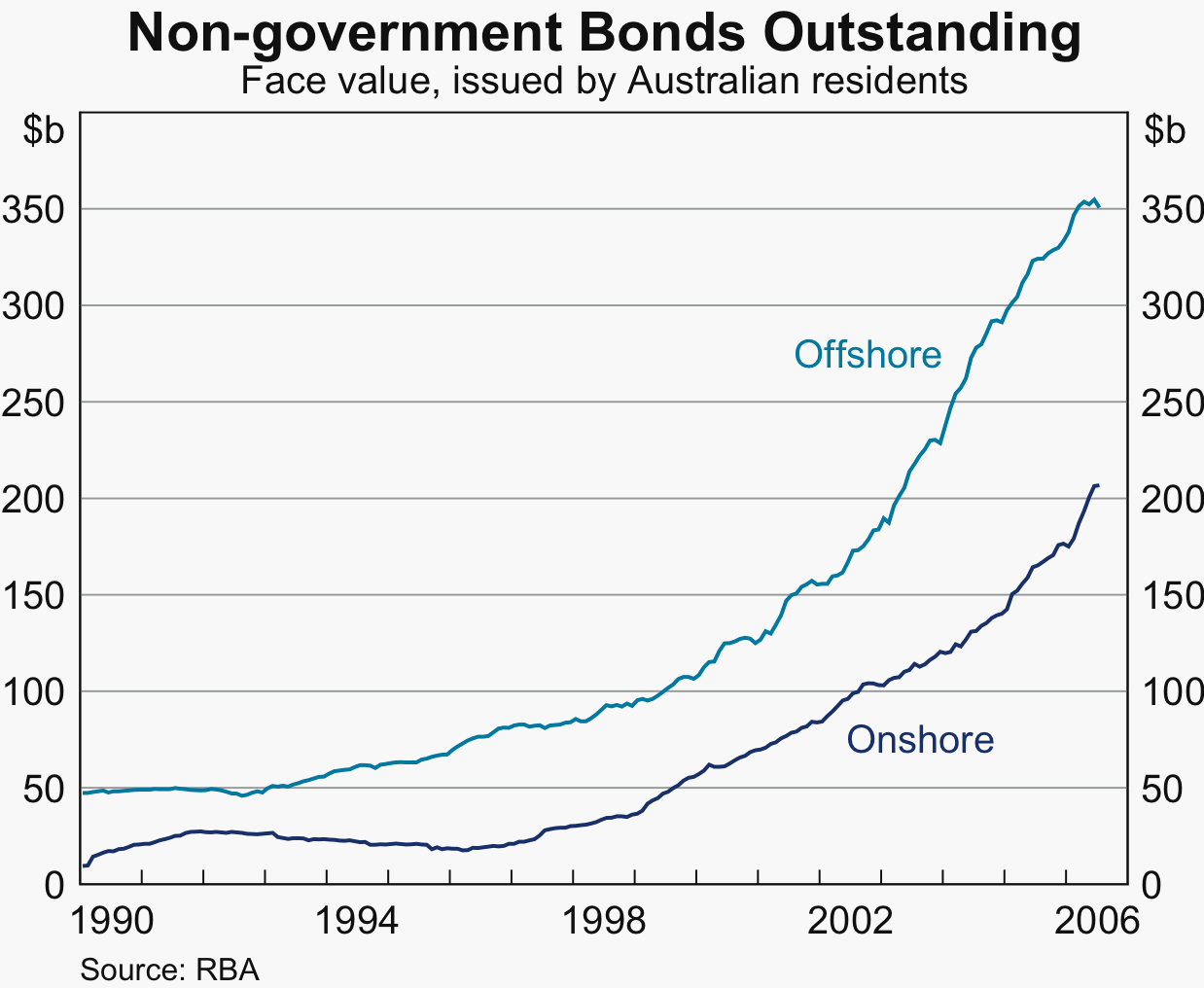
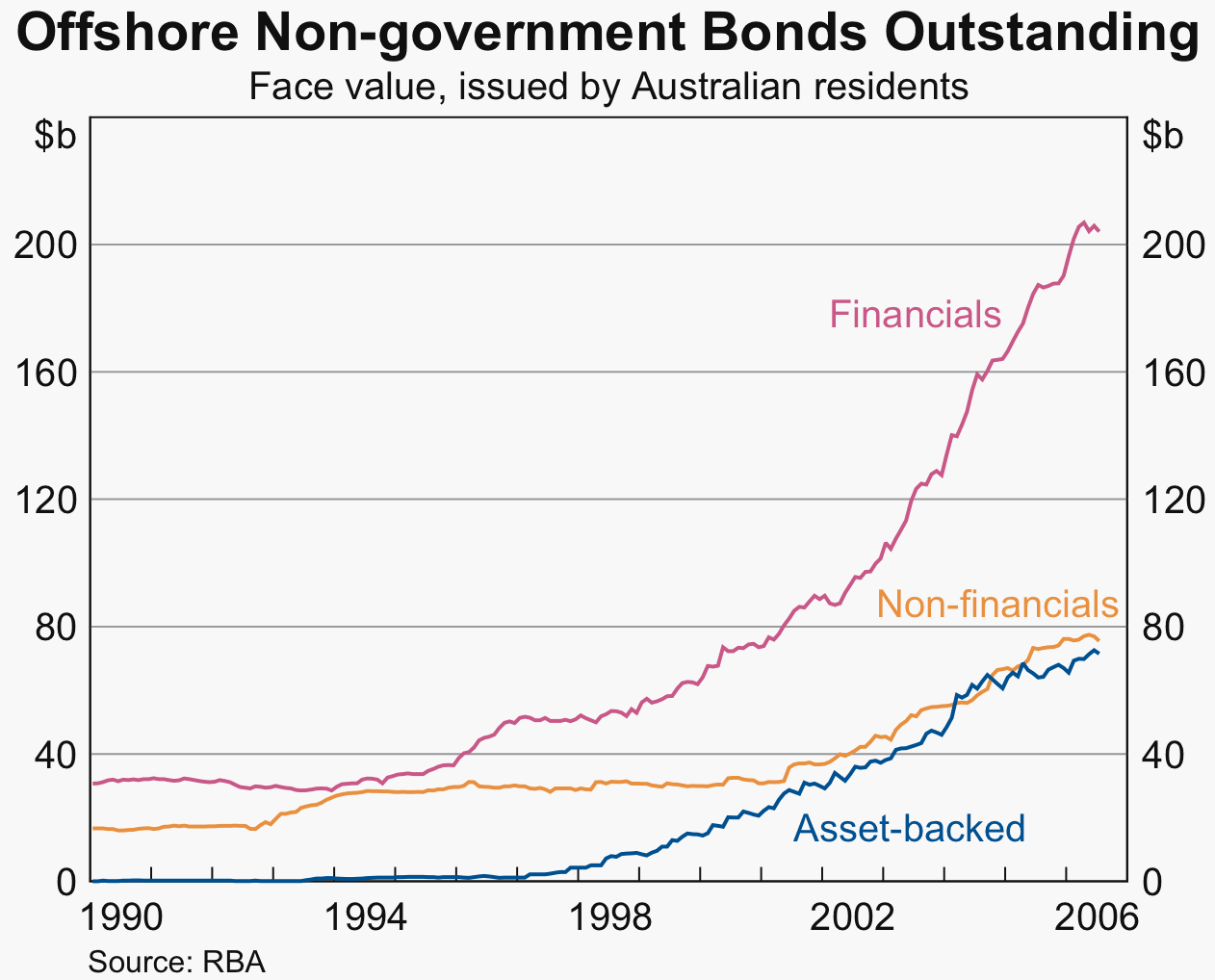
The extensive use of offshore markets reflects a number of considerations.[2] It allows issuers to access an investor base that is larger than that available domestically and that has the capacity to absorb bonds of a wider range of credit ratings and maturities. Shifting issuance to a range of offshore markets also provides a more diversified funding base.
A significant proportion of banks' offshore issues are in foreign currency, primarily in US dollars, probably reflecting the preference of overseas investors for bonds in their own currency. Over 90 per cent of the offshore issues are in foreign currency, of which around 40 per cent are in US dollars, whereas nearly all the domestic issues are in Australian dollars. Banks do, however, hedge themselves against any foreign currency risk by swapping their foreign currency issues back into Australian dollars.
Domestic issuance has also increased strongly (threefold) over the past five years. A substantial proportion of the growth in domestic issuance has been by non-residents, with the stock of non-resident bonds outstanding rising from around $20 billion in 2003 to be around $80 billion currently (Graph 3). This has reflected the fact that there is a sizeable global appetite for A$-denominated assets of internationally recognised institutions. The tendency of non-resident issuers to then swap their funding into foreign currency has been an important counterpart to the offshore issuance in foreign currency by Australian banks (see below).
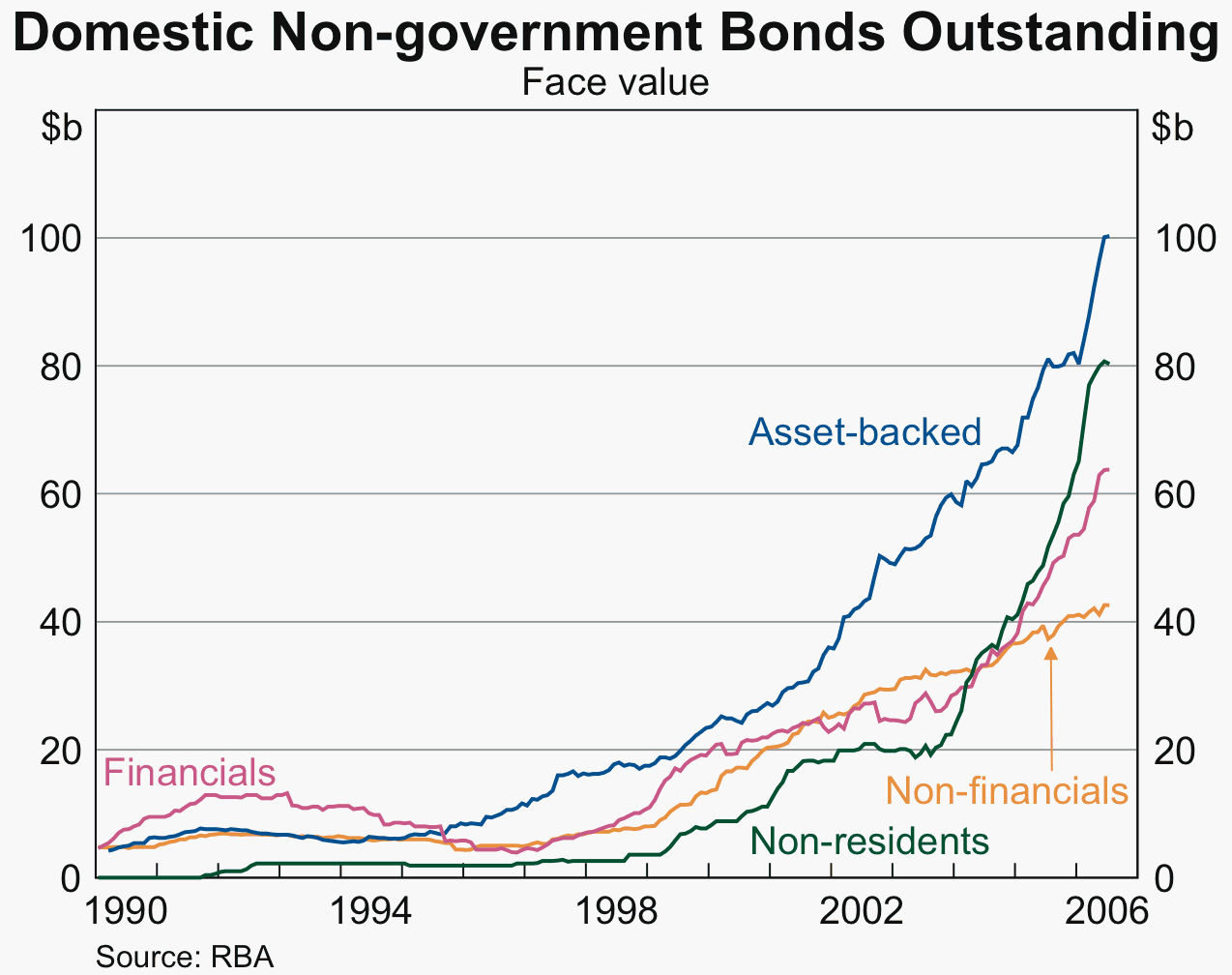
Comparing the Cost of Issuance across Markets
In comparing the cost of bond issuance across different markets it is necessary to account for variation in the characteristics of different bonds, such as bond maturity, credit rating, currency denomination and whether the bond offers a fixed or floating coupon payment.[3] The sizeable number of bonds issued by Australian banks into both the domestic and offshore markets over the past five years or so provide a large sample with which to make a cost comparison. A subset of banks' bond issues was chosen that allows a reliable comparison of costs across markets, and which is also likely to be representative of the banks' broader issuance activities. The characteristics of these bonds are shown in Table 1.[4]
| Domestic issues | Offshore issues | |
|---|---|---|
| Currency | Australian dollars | US dollars and Australian dollars |
| Coupon type | Floating rate | Floating rate |
| Benchmark interest rate | 3-month A$ BBSW | 3-month US$ LIBOR or 3-month A$ BBSW |
| Credit rating | AA– (S&P) | AA– (S&P) |
| Maturity | 3 to 5 years | 3 to 5 years |
| Average issue size | A$304 million | A$356 million |
| Number of bonds | 41 | 49 |
| Number of issuers | 5 | 8 |
|
Source: RBA |
The cost of US$-denominated issuance in offshore markets is converted from a spread to US$ LIBOR to a spread to the A$ bank bill swap rate (BBSW) using the basis swap spread from a cross-currency interest rate swap of the appropriate maturity.[5] That is, the analysis assumes that Australian banks' bond issues in US dollars are hedged back into Australian dollars. This assumption is strongly supported by recent survey data from the Australian Bureau of Statistics (Cat No 5308.0) which show that banks almost completely hedge their foreign-currency bond issues back into Australian dollars.[6] The survey data indicate that banks are not attempting to take advantage of a lower foreign interest rate by issuing bonds offshore in foreign currencies while leaving themselves exposed to the risk of an adverse currency movement. Rather, they are seeking to gain incremental reductions in funding costs by accessing the larger pool of investment funds available offshore. Banks intend to maintain the exposure in Australian dollars and accept that this effectively means paying an Australian interest rate.
After accounting for hedging, the costs incurred by Australian banks in issuing bonds into the domestic and offshore markets are shown in Graph 4. While there is somewhat more variation in cost when issuing into offshore markets, there is no systematic cost difference across markets. Indeed, the weighted average spread to the swap rate since 2001 is 14 basis points for both domestic and offshore issues by Australian banks. The greater variation in offshore issuance cost largely reflects movement in the basis swap spread on cross-currency interest rate swaps used by banks to hedge their foreign-currency exposure.[7]
While the average cost of issuing bonds into domestic and offshore markets is similar over time, short-term cost differentials do arise from time to time. A particularly notable example is the period from late 2002 to mid 2003. During this period, a substantial fall in the basis swap spread on cross-currency interest rate swaps allowed banks to fund themselves substantially more cheaply offshore than onshore (Graphs 4 and 5).
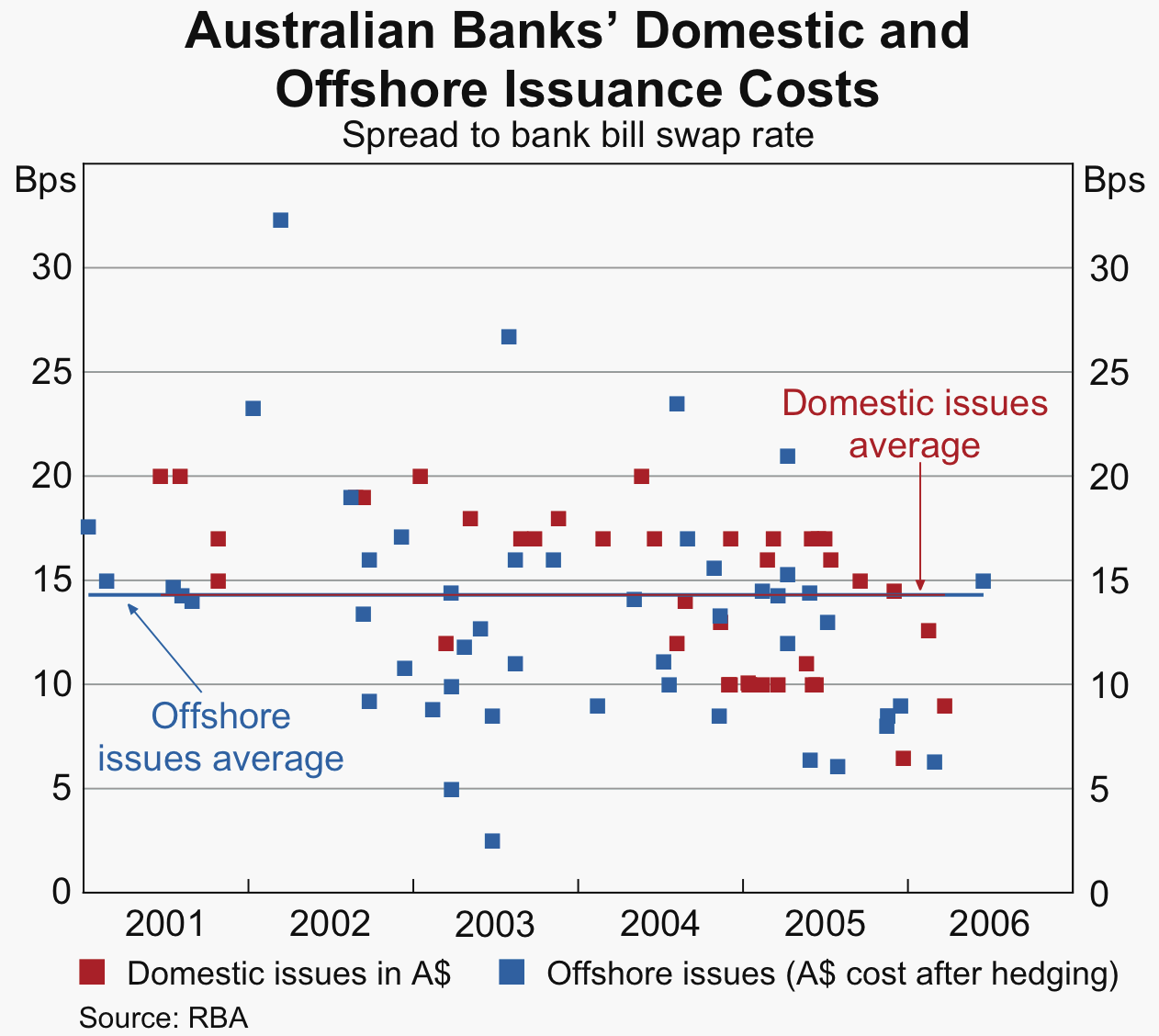
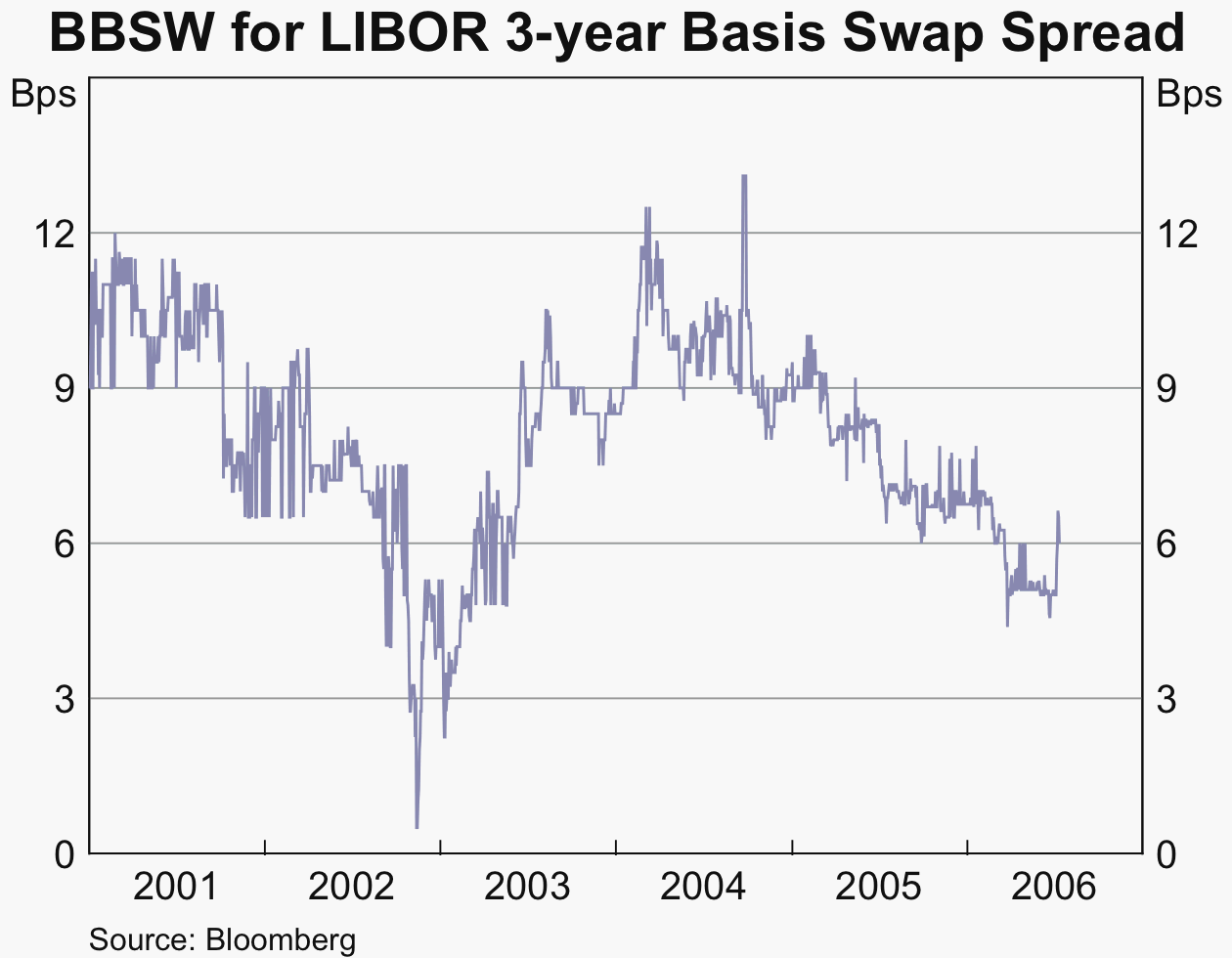
This decline in the basis swap spread resulted from the increased issuance of Australian dollar Eurobonds (such as Uridashi bonds) by non-resident issuers around this period, which reflected the strong demand for Australian-dollar assets at the time. These non-resident issuers typically swapped their funding from Australian dollars into their own domestic currency, putting downward pressure on the basis swap spread. This increase in demand by foreign investors for Australian-dollar assets made it more cost effective for Australian issuers to issue foreign currency-denominated bonds and swap them back into Australian dollars. It also allowed domestic issuers to increase their offshore issuance of A$-denominated bonds.
Comparing Costs across Different Issuers
Concerns have been raised that the magnitude of Australia's foreign liabilities may result in Australian entities paying an ‘Australian premium’ when raising funds offshore. While the above analysis illustrates that the costs incurred by Australian banks have been similar on average over time whether they issued bonds domestically or offshore, it does not demonstrate how these costs compare with those incurred by similar foreign banks. Hence the issue of whether the significant use of offshore funding by Australian banks has resulted in higher costs relative to US banks issuing in the US market is investigated, to assess whether foreign markets are willing to absorb these bonds at a similar cost. Table 2 shows the sample of bonds used to make this comparison.
| US bank issues | Australian bank issues | |
|---|---|---|
| Currency | US dollars | US dollars |
| Coupon type | Floating rate | Floating rate |
| Benchmark interest rate | 3-month US$ LIBOR | 3-month US$ LIBOR |
| Credit rating | AA– (S&P) | AA–(S&P) |
| Maturity | 3 to 5 years | 3 to 5 years |
| Average issue size | US$334 million | US$283 million |
| Number of bonds | 58 | 52 |
| Number of issuers | 16 | 7 |
|
Source: RBA; Thomson Financial |
Graph 6 shows that the average cost of US$-denominated bond issuance for Australian and US banks has been similar over time. The weighted average spread to US$ LIBOR for Australian and US banks since 1997 is 7 basis points and 8 basis points, respectively. Overall, these results suggest that Australian banks issuing bonds offshore have established a sound reputation in foreign markets and that these markets have willingly purchased new bonds at a cost to Australian issuers that is comparable to the cost incurred by foreign banks. This is a reflection of the quality of the asset books of Australian banks, which has seen them maintain their strong credit ratings over time.
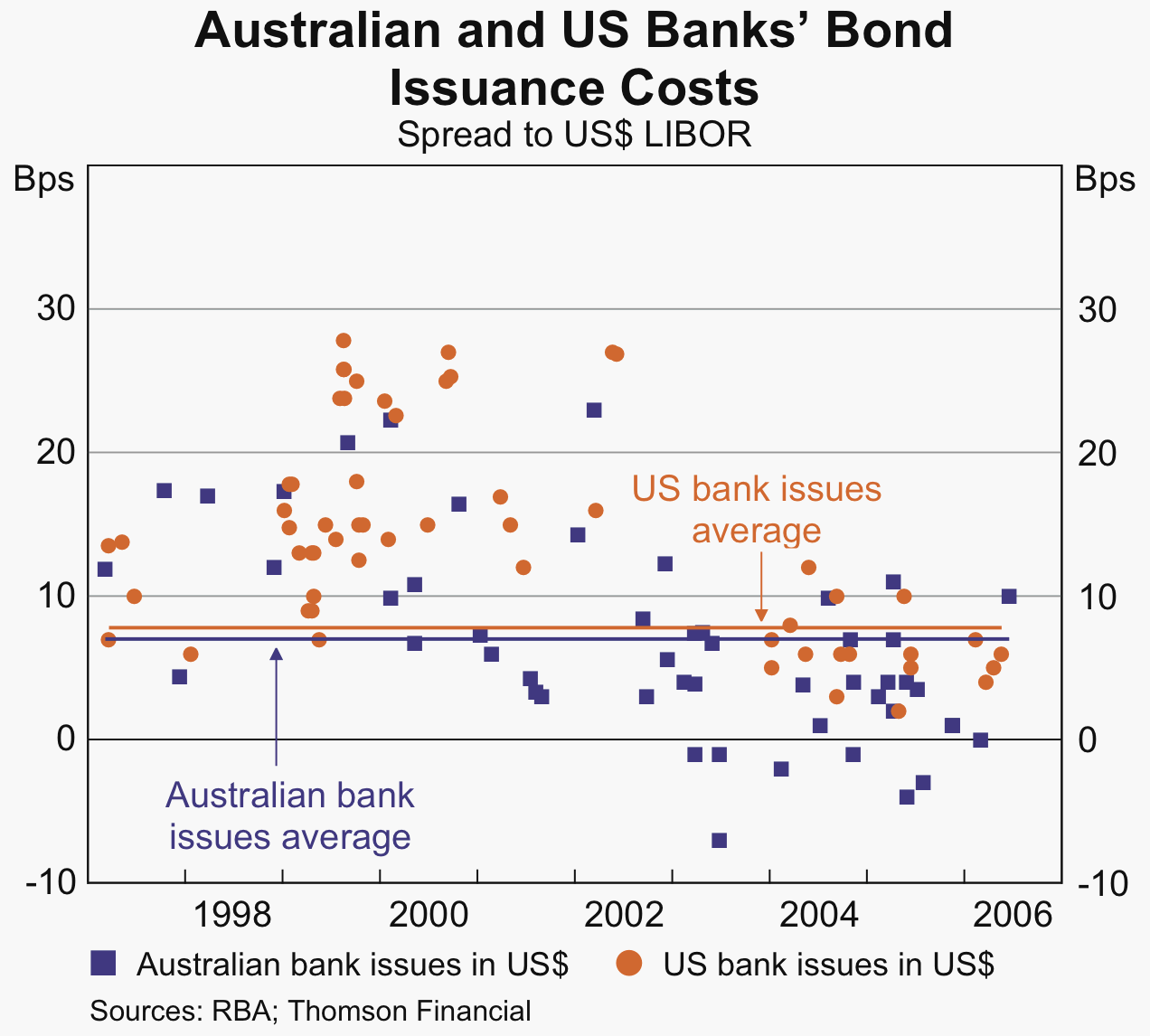
Conclusion
In recent years, Australian banks have been active in issuing bonds into both domestic and offshore markets. The evidence presented in this paper suggests that over time banks' average cost of issuance across these markets has been similar. Banks vary their source of funding in response to relatively small changes in costs in different markets. The significantly larger funding base that is made available to banks by having access to both domestic and offshore markets is likely to have reduced their overall funding costs. The general global appetite for A$-denominated assets has allowed Australian institutions either to raise funds offshore in Australian dollars or hedge foreign-currency issuance back into Australian dollars. Finally, no evidence was found to suggest that the level of offshore issuance has led to any ‘Australian premium’, whereby domestic banks need to pay a higher return than similar institutions in the US.
Footnotes
This article was written by Market Analysis section in International Department. [1]
See Battellino (2002), ‘Why Do So Many Australian Borrowers Issue Bonds Offshore?’, Reserve Bank of Australia Bulletin, December, pp 19–24. [2]
There are other characteristics of bonds that will also affect the cost of issuance such as whether the bond is ‘credit-wrapped’ (backed by third-party credit support), subordinated or ‘structured’ (e.g. the value at maturity is linked to an equity market index). [3]
We have chosen a sample period starting in 2001 as domestic issues with the required characteristics to make a comparison with offshore issues are relatively sparse before then. [4]
The counterparties to a common AUD/USD cross-currency interest rate swap exchange a stream of payments, with one party paying the A$ bank bill swap rate (BBSW) and receiving the US$ London Interbank Offered Rate (LIBOR), while the other party does the opposite. The basis swap spread represents the premium paid by the counterparty paying BBSW. The effective A$ cost of issuing US$-denominated bonds offshore and hedging back into Australian dollars (as a spread to A$ BBSW) is the US$ spread to LIBOR plus the basis swap spread. The basis swap spread is usually small and positive, reflecting greater market demand to pay A$ BBSW and receive US$ LIBOR, although it has been negative on occasion. [5]
For a further discussion of this issue see RBA Bulletin article ‘Australia's Foreign Currency Exposure and Hedging Practices’, December 2005, pp 1–8. [6]
Part of the variation also reflects the slightly different sample of issuers. The additional banks in our sample of banks issuing bonds offshore are smaller and have less regular presence in offshore markets than other banks in the sample. While these additional banks only account for a small proportion of the total offshore issues in the sample, the three highest-cost offshore issues were made by these smaller banks. [7]